Do you feel like your site should be earning more?
Hey, you and everybody else. We can’t help everybody else, but we can help you.
In this post, we will show you how to make more money with your Amazon affiliate site. These are the same tactics that we use to boost our affiliate sales and give your site the maximum chance for success.
Read on to learn how you can earn more money with your Amazon associate site.
Focus On High Converting Content
Marketing is the art of showing the right product to the right people. And your product (content) might be great, but what if it’s bringing in the wrong people?
Earning more with the Amazon affiliate program doesn’t start by improving your content…
It starts by improving your keyword research.
In our experience, two types of articles perform are highest-converting affiliates:
- Best X for Y. This is the stereotypical buying guide. Something like “best family tent for bad weather”.
- X product review. This is where you review a single product. Something like “coleman weathermaster tent review”.
These types of keywords are the bread-and-butter of Amazon affiliate marketing. It’s not that we can’t earn money with other keywords, it’s that these keywords are the sweet spot where we solve someone’s need. This works much better than just throwing an Amazon affiliate link into a random article.
Want a profit-generating affiliate website? At Investors Club, we sell established content sites in a wide variety of niches. Check our listings to see the sites currently available.
Have No Fear, An Affiliate Is Here


What value does an affiliate provide to the world?
I’d be willing to bet that between the Facebook ads showing lambos and the YouTube ads showing lambos, not many affiliates have given it much thought.
The value we provide to the world is simple, but profound.
We help people save time and make decisions.
Someone wants to buy a new bed and a new chew toy for her kid and for her dog. She decides that the kid will be good with any chew toy, but the dog needs a great bed.
She knows what she needs (a great dog bed), but she doesn’t know which one is right for her.
And instead of making her open up 20 tabs on Amazon, read through product descriptions, check the reviews for anything less than 4 stars, and compare pricing…
We affiliates say “Hey, I’ll do that work for you. I’ll produce an amazing write-up and you can just check that out instead of wasting hours of your time.”
This brings us back to our high-converting keywords. Because what will this lady search for online when she needs a dog bed, but isn’t sure which one is right?
She’ll search for something like “best dog bed for long-haired dogs“. And once she finds one she likes, she might search “Woofer long-haired dog bed review” (We just made the company name Woofer up).
And she’ll land on an affiliates page.
The reason these keywords convert better is because they have buyer intent. The Ahrefs blog has a great article on search intent, so I won’t go too in-depth here.
The gist is this: People search some keywords when they want to spend money. They search other keywords when they just want info.
This also explains which kind of traffic is going to be the highest-converting for us.
We’ll put it this way:
Social is sexy, but SEO pays the bills.
SEO traffic often converts at higher rates for Amazon affiliate sites than social traffic. This is due to the reasons why people use search engines versus social media.
When someone is on Facebook, Pinterest, or name-your-platform, they’re often there to hang out. They want to see their friends, learn what’s up, know new people.
Except on TikTok, where they just want to know new people in a biblical sense…
People aren’t often on social media to buy.
But when someone searches on social media, we can filter out all the people who aren’t looking to buy. We can find those who are looking to buy and make sure that they’re the ones who land on our site.
Search engine traffic (SEO) will almost always be the highest-converting, consistent form of traffic for affiliates. It’s too easy to get our right product in front of the right people.
So we as affiliates want to target the keywords where people want to spend money. In particular, the keywords where they know what they want to buy, they just don’t know which one they want to buy…
So how do we find these keywords in droves?
Finding Magic Keywords
Think I’m exaggerating when we say “magic”?
I’m not. The difference these buyer intent keywords made in your business will be life-changing.
It all starts with a keyword research tool. Ahrefs is our preference, but any keyword research tool where you can see the SERPs at a glance will be perfect for this.
We’re going to start by putting in a seed keyword (just a basic term for your niche) or a series of seed keywords. In the Ahrefs Keyword Explorer, I typed in “camp, camping, tent, sleeping bag”. Basically, start with an affiliate product that fits in your chosen product category.
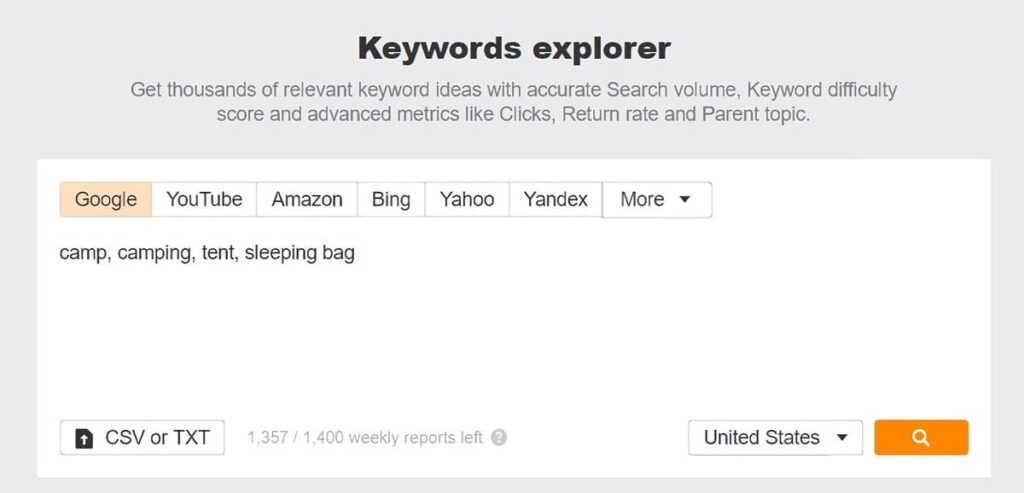

And we hit search. Ahrefs will show us their analysis of these 4 keywords, but this isn’t what we’re interested in.
Click on “All Keyword Ideas” over to the left of the screen.
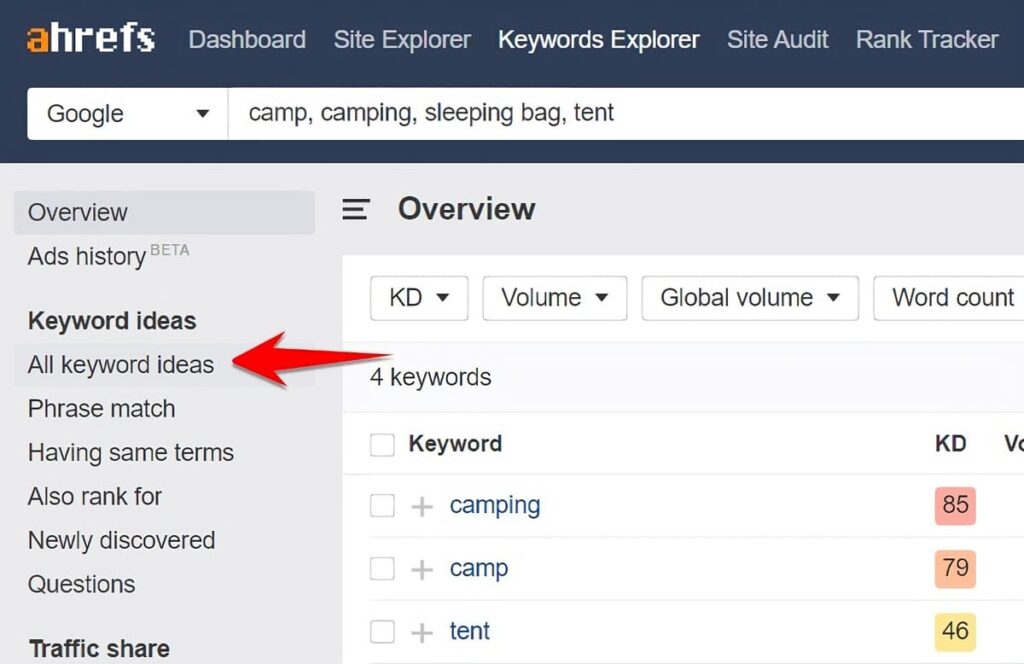

And we’re going to end up with a lot of keywords (I got 3,336,256 keywords), so we need to add some filters.
I’ll use the following filters:
- KD: 0-10. I don’t trust keyword difficulty scores on any tool, but they are super useful for broad filtering.
- Word Count: 3+. This makes sure we’re getting long tail keywords. Sometimes I like to go to 5+.
- Include: Any of “best”, “review”. This makes sure we’re getting the buyer intent keywords that we’re looking for.
My final results look like this:
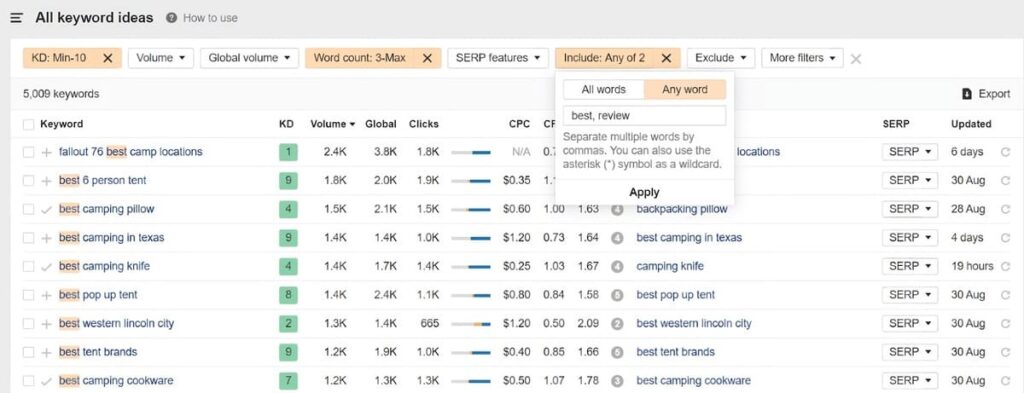

And this is where most keyword research stops…
Most people download their filtered list and are off to the races…
But not us. We’re find the best of the best keywords.
First we need to click that little SERP button to the right of the page:
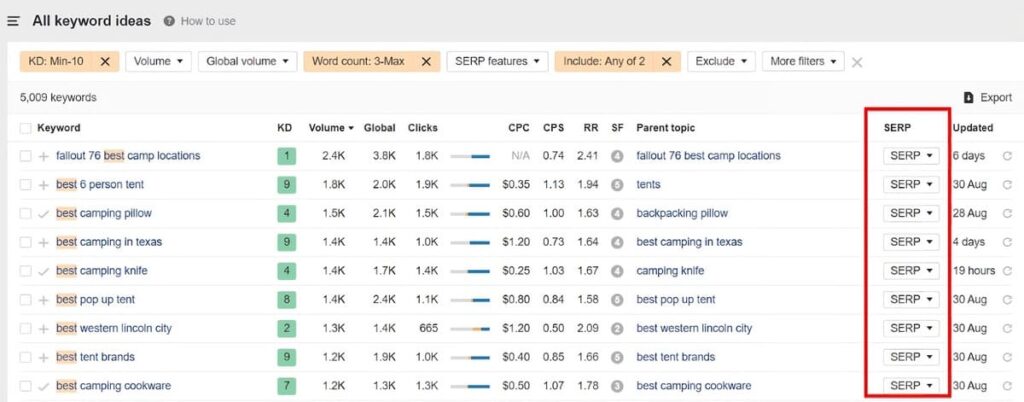

That little button is going to show us the entire first page of Google for each of those keywords…
And it holds the secret to improving your Amazon earnings as a content creator.
Go through the first page of the Keyword Explorer and open up a bunch of keywords. We’re going to be on the lookout for a few things:
- We want to find keywords with at least 2 keywords under Domain Rating (DR) 25 on the first page of Google
- We want to verify that these low-DR sites don’t have many backlinks or referring domains (RD). I prefer that sites have <5 RD to the page we’re looking at. I like to look at RD more than backlinks, since additional backlinks from the same site decrease in power
Once you find a keyword that’s good, it will look something like this (red are columns we look at, black are low-competition results)
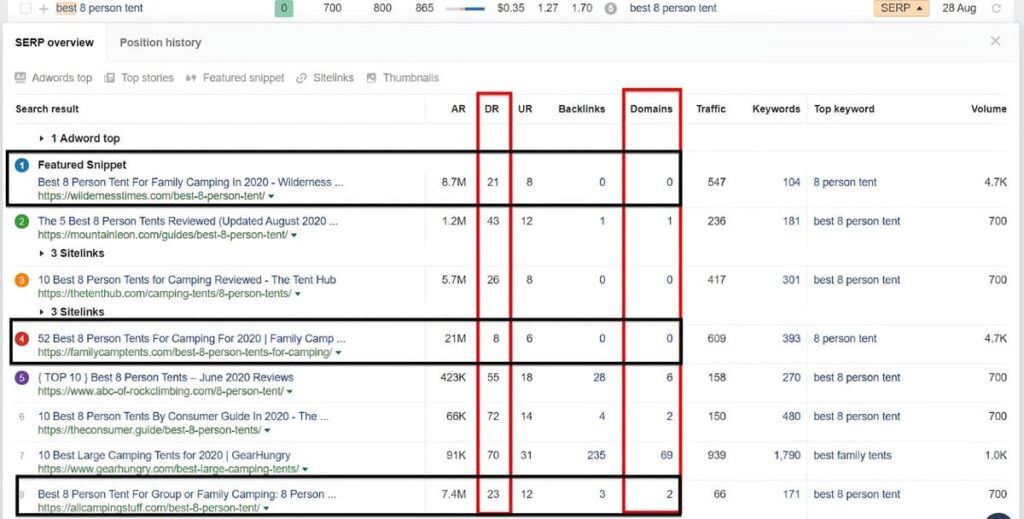

These are the keywords you need to target with your digital marketing. Several low DR sites ranking, none of whom have many referring domains linking to them.
That’s a low-competition, buyer-intent keyword. Targeting those is the first step to increasing your Amazon Associates earnings.
Audit Your Links
As an affiliate marketer, the only thing sexier than an audit is the extra money in your bank account next month.
You might need to repeat that a few times to help it sink in. No one loves an audit, and I don’t suggest you do one by hand.
I don’t even suggest that you hire a poor soul as a virtual assistant to do it for you.
But site audits are powerful for a few reasons.
- Your products might be missing affiliate links (or have affiliate links that aren’t yours – sometimes those writers have a little too much hustle)
- You might be linking to products that are out of stock
- Your pages might be missing appropriate disclaimers
All of these are devastating to any affiliate:
Missing or incorrect affiliate links robs you of the income you should be earning. In our experience, no one thinks they have missing or wrong affiliate links…
But almost every site does. And that broken or missing Amazon link is costing you money.
This could be caused by a simple mistake by a VA to malicious intent; it’s surprising how often site owners realize that their writers are inserting their own affiliate codes.
Or perhaps you’re linking to out of stock products. Instead of landing on the page they want, visitors hit a dead page…
And instead of buying, they bounce. They’re gone.
You lost a conversion.
But perhaps worst of all, missing disclaimers could get you banned from Amazon or even put you in trouble with the SEC.
Instead of trying to audit every page and link on your own, we recommend using SiteBuddy.
SiteBuddy will scan your site and tell you a few things:
Sign up for SiteBuddy, download the results, and hand it off to the VA to fix.
There. Audit done.
Now let’s chat about the winning-est strategy…
Win By Outproducing
Remember those low-competition keywords we found ways up the page?
You’re about to need more of them.
A lot more of them.
Because at the end of the day, he who has the most content…
Wins.
The key with content is to find the right balance between quality and quantity.
It’s great to have a bunch of posts…
And it’s great to have a single amazing post…
But the sweet spot is somewhere in between those two things. The highest ROI often doesn’t come from maxing out on quality or quantity, but on combining them.
Strive to produce amazing content for your audience. Be the best in your niche if it’s possible.
But don’t waste weeks or months on a single post. Crank it out, get it done, move on to the next one.
There are a few ways to produce quality at scale.
- Remove fluff from your content. Don’t stuff word count for the sake of stuffing word count. Every word should add value
- Be graphic. Show some images, slap some color on that page of yours. But don’t download these from Amazon
- Explain which product is best for which person. Instead of having a top 5 list in order of 1 to 5, explain that this product is best overall, that one is best for long haired dogs, another is best for short haired dogs, and that one over there is the best budget one
- Be honest with pros and cons. Readers can smell a sale from a mile away. Be honest in your explanation of cons for the product.
- Add some personality. Be yourself. Don’t be robotic; show that you’re a real person with emotions. Add humor if you’re funny. If you aren’t funny, pass on the jokes. Lots of laughs can fall flat in writing
If you’re hiring out content (like with us), then it’s wise to have a “brand package”. Explain who your target audience is, what your brand’s personality is, and how to connect with your audience.
This ensures uniform content and helps keep all new content in line with your aim.
How Much Content Is Right?
Let’s get to it: how much original content do you need to make big lambo bucks and be surrounded by supermodels with your Amazon niche site?
We’ll tell you when we get there.
Seriously, it’s tough to say how much content you’ll need to make $X per month. It’s different from every niche.
Some people we know make $700/month just from 10 blog posts. That’s a non-standard result, but it happens.
In general, we recommend setting small goals: Try to have 10 posts, then 25. Go for 50, 100, 1,000.
We don’t know anyone who has 3 digits worth of quality posts on an Amazon affiliate website that isn’t seeing a pretty serious ROI.
At the end of the day, it’s hard to place an “upper limit” on how much content you should have. But it’s also hard to place a “lower limit”: what is the minimum viable product?
If you’re producing content yourself, strive for 1 post per week. More is great if you can, but 1 per week will be awesome.
Most people getting into affiliate marketing are inconsistent; they’ll publish 4 posts the first month, then 2 the next, then 1, then…
Next thing you know, they’re complaining in a Facebook group how the model doesn’t work.
The truth is that they were inconsistent. If you’re on a budget and writing yourself, try to produce 1 post per week, every week.
No exceptions.
The truth is that it isn’t hard to outproduce most websites. People are lazy. Exploit that by working hard in your free time, and trusting that the process will work to generate affiliate commission.
And then once you have some cash you can invest in your site, content is a good investment. Each new piece of content is another opportunity to rank on the first page of Google.
At the end of the day, the winning-est winners win by outproducing the competition.
Hard work scales. Use it to win.
Wrapping It Up
There are a few tactics that have outsized risk vs reward profiles:
Targeting good keywords is one of them. You can do this with new content or by revamping existing content.
Site audits are another. You’ll be surprised at how much money you’re losing, so give your site a quick glance with SiteBuddy.
Content production doesn’t have this same asymmetric reward to risk, but it is the overall winning strategy.
These sites might not be easy. But they are worth it for your online business. Follow the tactics in this ultimate guide and you’ll be well on your way.